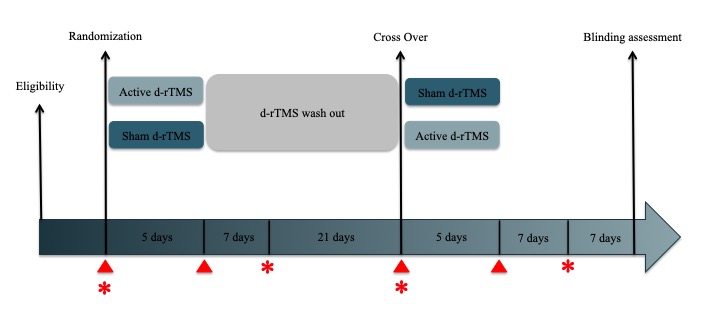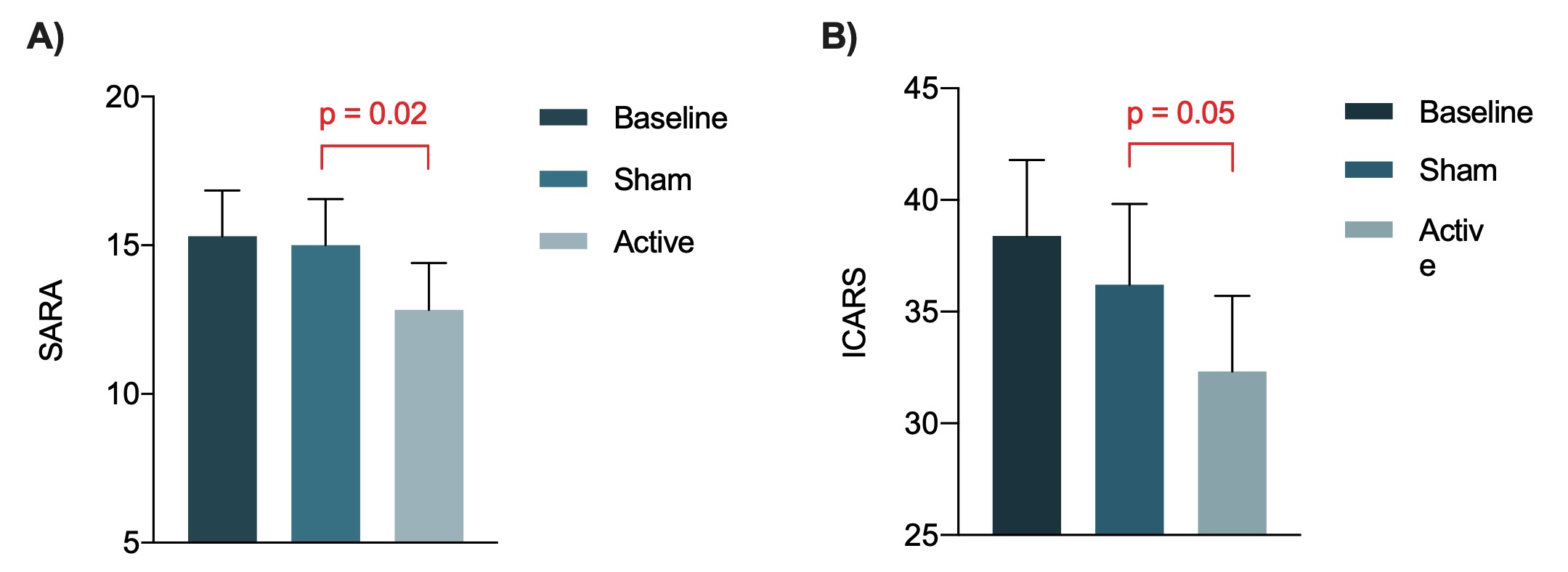Category: Ataxia
Objective: To investigate whether cerebellar deep repetitive transcranial magnetic stimulation (d-rTMS) can improve ataxic symptoms when compared to sham stimulation.
Background: Cerebellar ataxia remains a neurological symptom orphan of treatment interventions, despite being prevalent and incapacitating. Previous studies have investigated the effects of cerebellar neuromodulation in ataxic patients in an exploratory manner [1].
Method: In this randomized, sham-controlled, crossover trial, we included patients with scores > 6 on the Scale for the Assessment and Rating of Ataxia (SARA) and genetic diagnosis of spinocerebellar ataxia type 3, clinical diagnosis of multiple systems atrophy cerebellar type, or post-lesion ataxia due to neurosurgery or stroke. Patients received five sessions each of sham and neuronavigated active 1 Hz d-rTMS to the dentate nucleus using a double-cone coil in randomized order with a 28-day minimum washout period between phases [figure 1]. Our primary outcome was the decrease in SARA when comparing phases (active x sham). Secondary outcomes measures included the International Cooperative Ataxia Rating Scale (ICARS), and other motor, cognitive, and quality of life scales. This study was registered at the clinicaltrials.gov under protocol NCT03213106.
Results: Twenty-four patients aged 29–74 years were included in our trial. After active d-rTMS, SARA was significantly lower than the score after sham d-rTMS (mean ± standard deviation [SD] of 12·8 ± 7·7 versus 15·0 ± 7·6; p = 0·002, figure 2A). The ICARS score also improved after active d-rTMS versus sham (32·3 ± 15·9 versus 36·2 ± 7·6; p = 0·005, figure 2B). Ratings of other motor scales, quality of life, and cognitive measures were not significantly modified by stimulation. No patient presented severe side effects, and nine presented mild and self-limited symptoms.
Conclusion: These preliminary findings suggest that d-rTMS of the cerebellum may improve ataxic symptoms in patients with different types of ataxia. The study protocol was safe and well-tolerated. These results provide reassurance about safety for clinical practice, and future studies should establish possibility to maintain these effects in the long-term.
References: [1] França C, de Andrade DC, Teixeira MJ, Galhardoni R, Silva V, Barbosa ER, et al. Effects of cerebellar neuromodulation in movement disorders: A systematic review. Brain Stimulat 2018;11:249–60. https://doi.org/10.1016/j.brs.2017.11.015.
To cite this abstract in AMA style:
C. França, D. de Andrade, V. Silva, R. Galhardoni, E. Barbosa, M. Teixeira, R. Cury. Effects of deep transcranial magnetic stimulation of the cerebellum on cerebellar ataxias: A randomized, double-blind, cross-over clinical trial [abstract]. Mov Disord. 2020; 35 (suppl 1). https://www.mdsabstracts.org/abstract/effects-of-deep-transcranial-magnetic-stimulation-of-the-cerebellum-on-cerebellar-ataxias-a-randomized-double-blind-cross-over-clinical-trial/. Accessed December 27, 2025.« Back to MDS Virtual Congress 2020
MDS Abstracts - https://www.mdsabstracts.org/abstract/effects-of-deep-transcranial-magnetic-stimulation-of-the-cerebellum-on-cerebellar-ataxias-a-randomized-double-blind-cross-over-clinical-trial/


